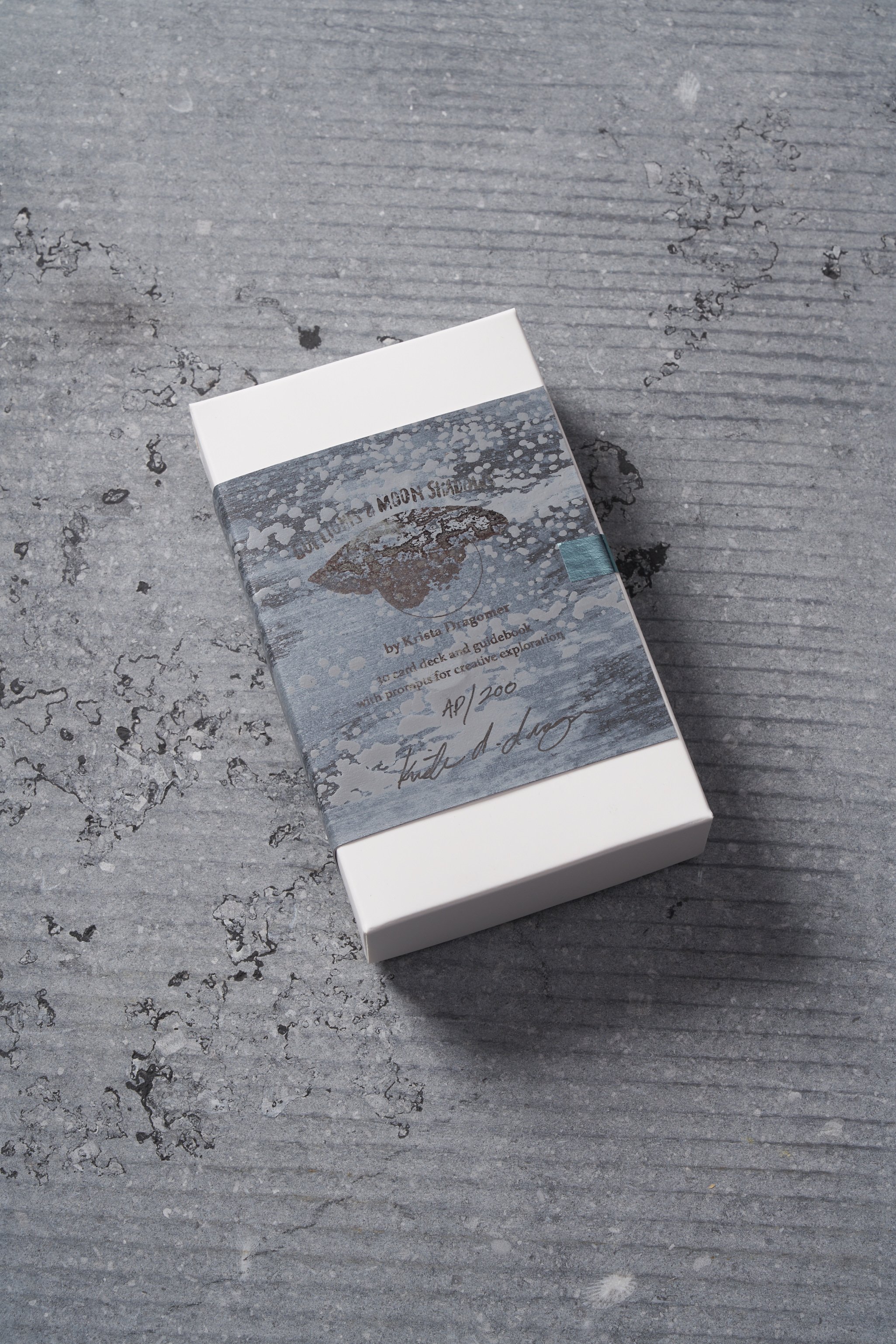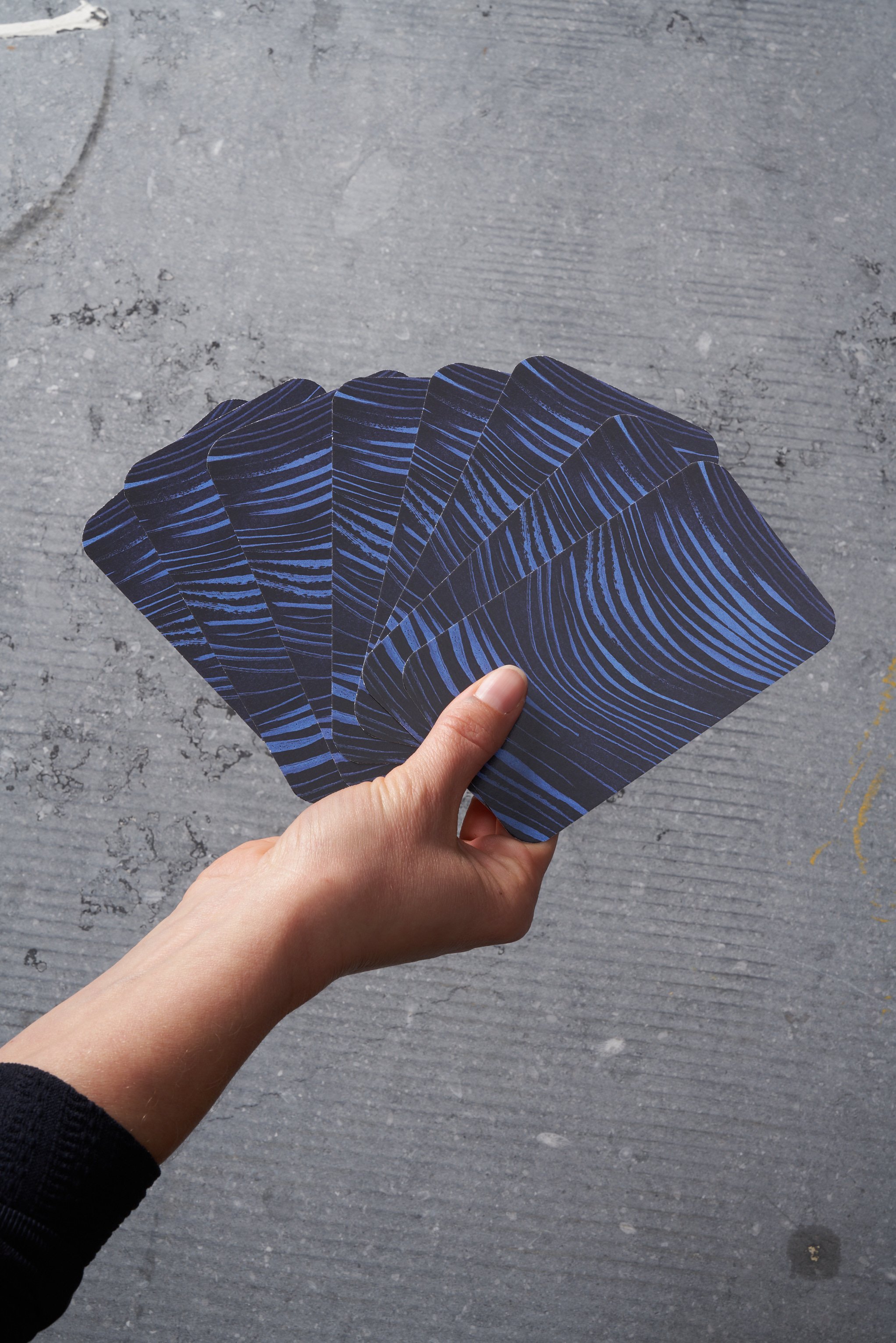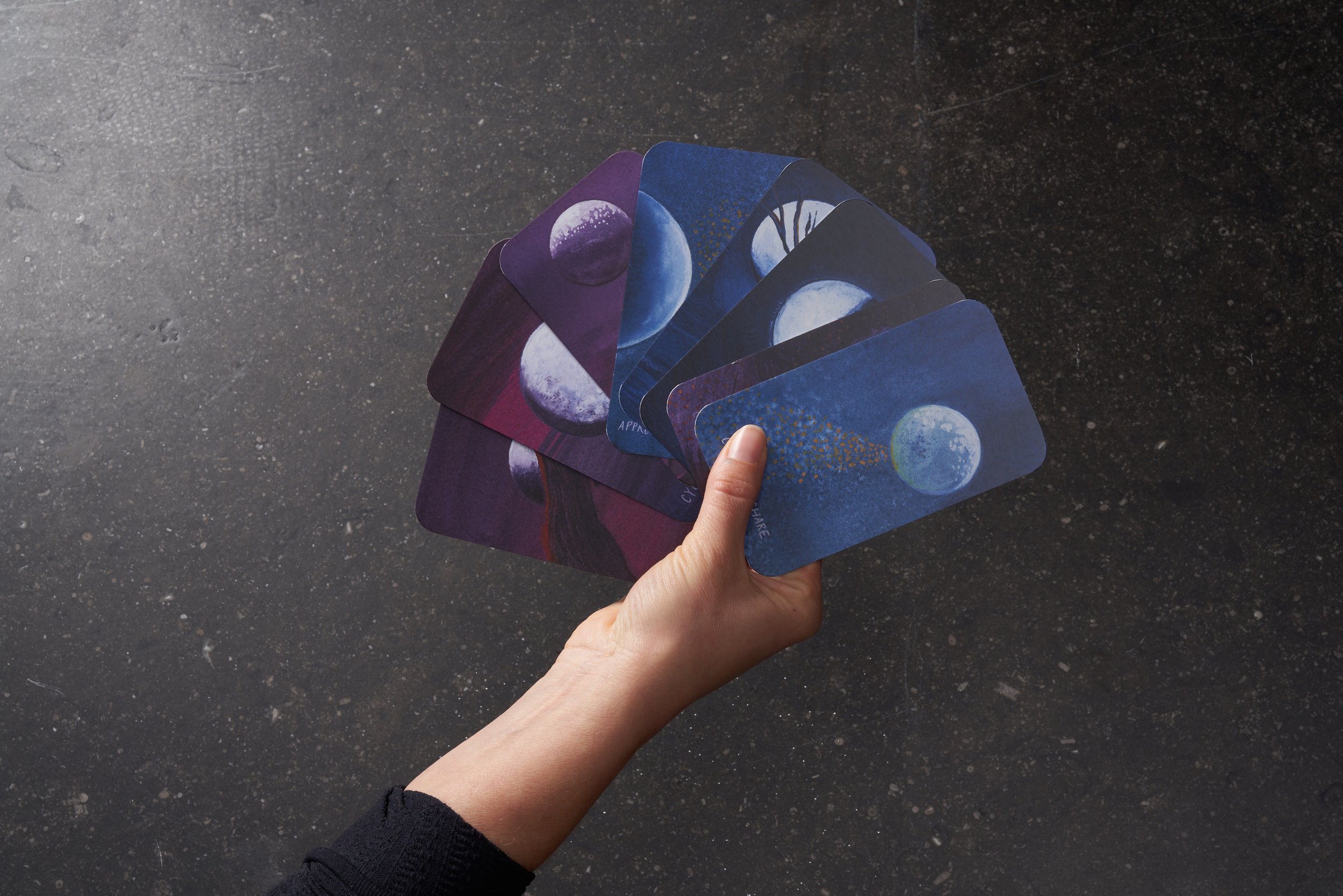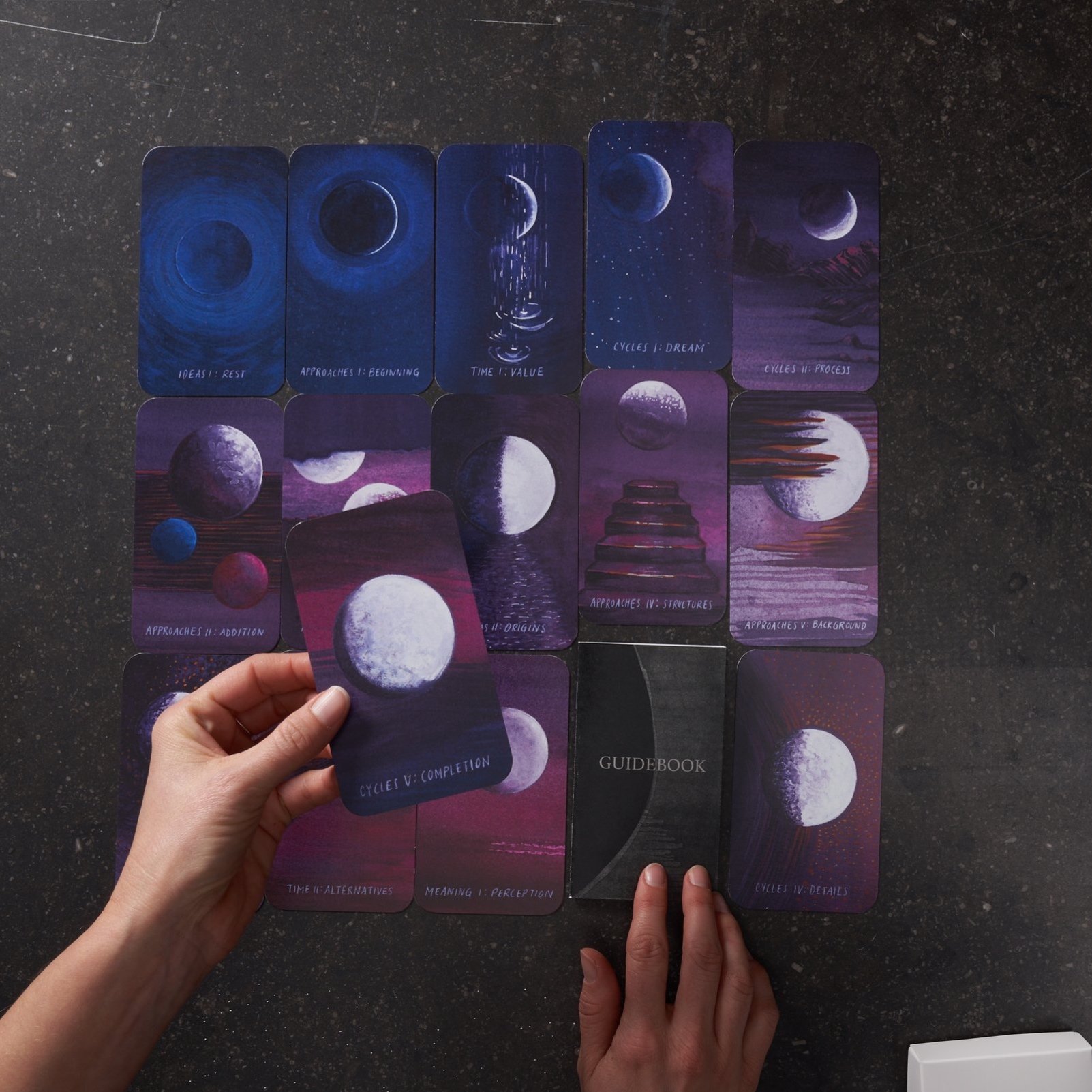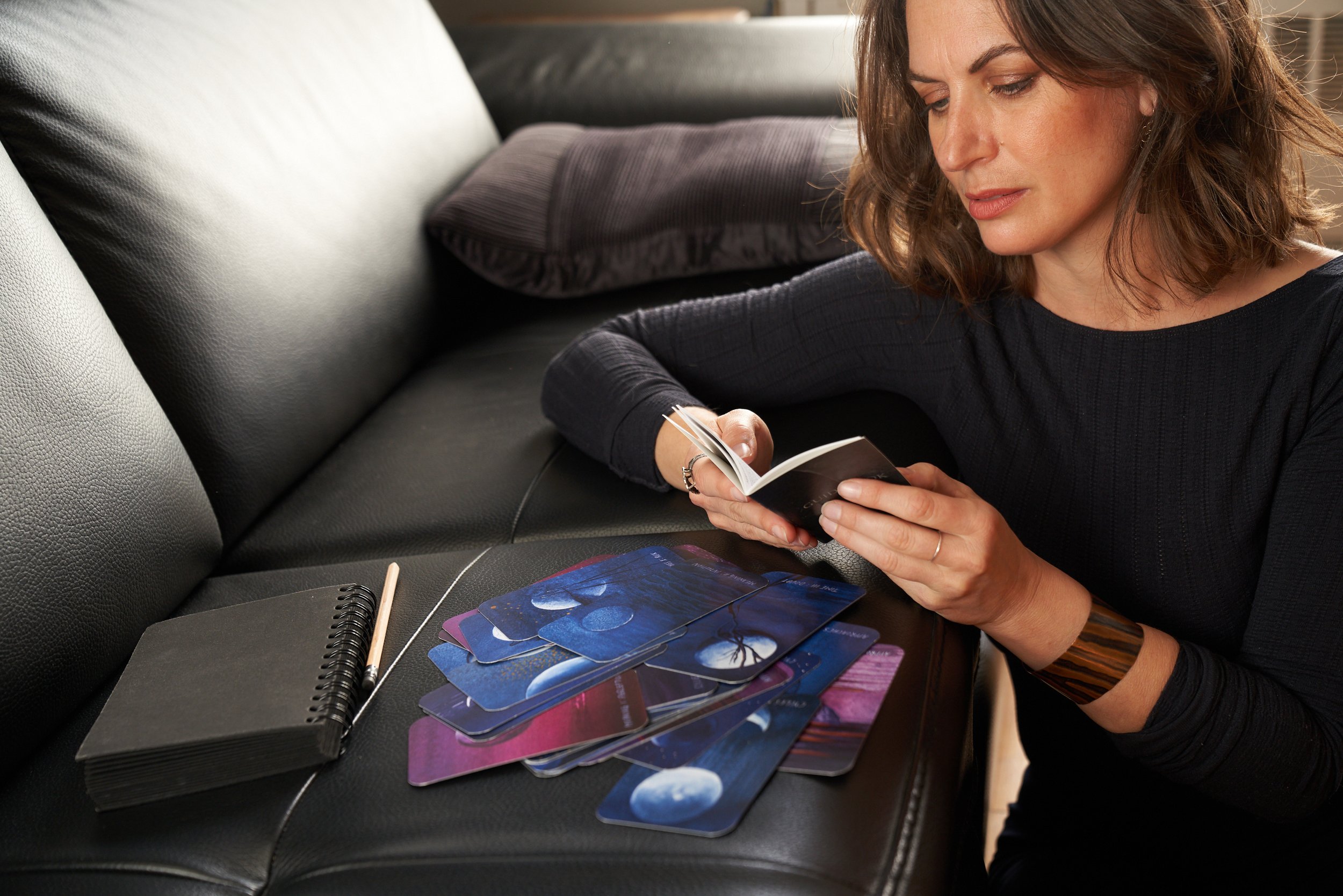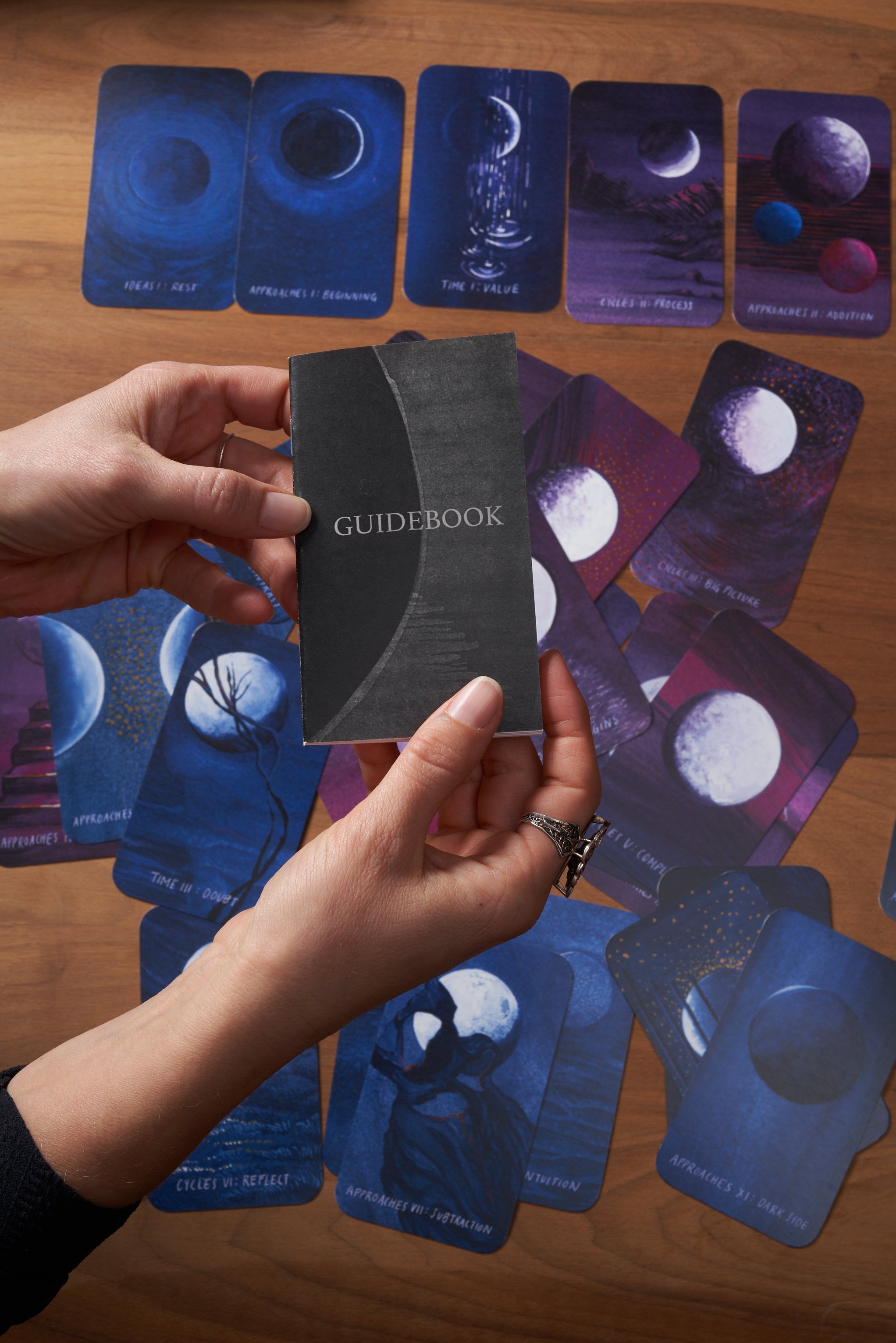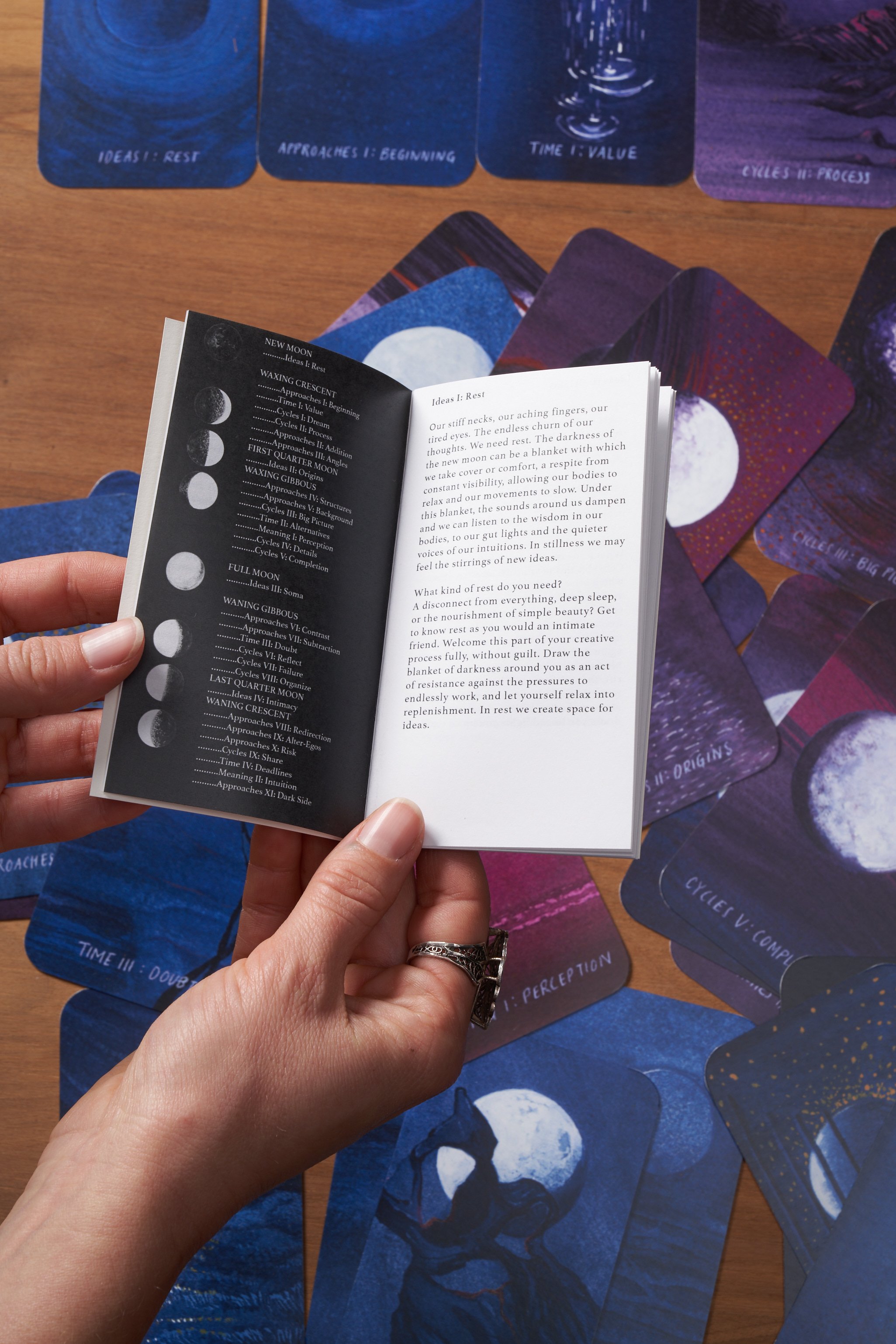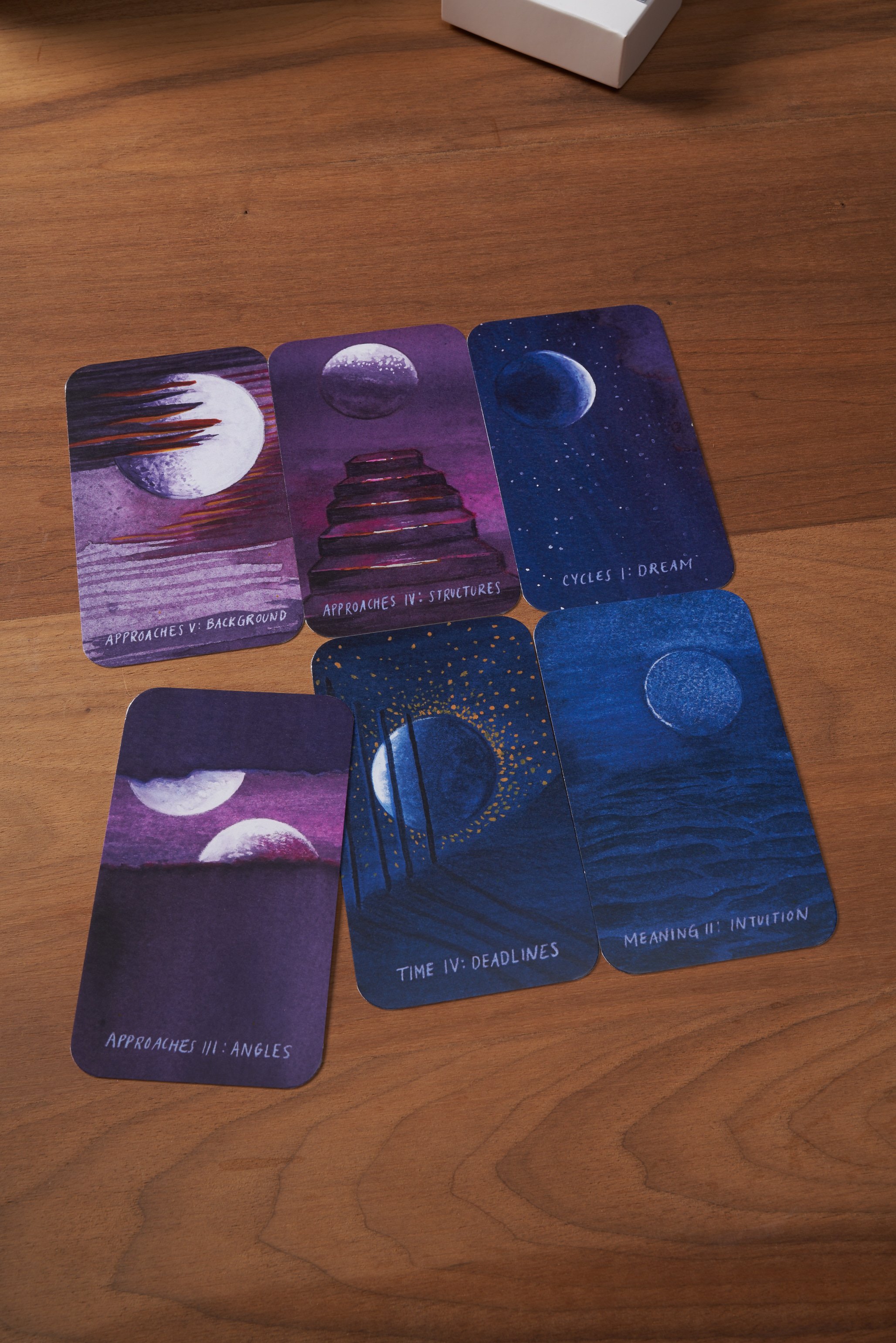This original artist deck is designed to help you realize your creativity. Each card is a reproduction of an original painting of the moon, accompanied by a guidebook with prompts for creative exploration. The deck explores topics like how do we come up with ideas, how do we start a project, what is our relationship to risk, doubt, structure, completion, how do we use our time – many different phases of the creative experience. I connected these phases to the phases of the moon as an inspiring and accessible metaphor that helps expand these explorations into a month-long practice.
Through a dedicated practice of art-making and reflection, I have observed themes, patterns, and processes that recur in my relationship with creativity. As I share these observations with others, through my teaching and mentorship practice, I have seen how these modes of interacting with creativity have facilitated rewarding turns of expression and self-discovery.
The deck is designed to be accessible to anyone interested in exploring creativity and can be used as a guide, a set of prompts, or a tool for reflection. You can use these prompts individually or in group discussions. They are written as explorations of creativity as a force, a process, and a companion in everyone’s lives, regardless of the kind of creative you believe yourself to be, even if you have never made anything you would call artistic. The cards can be useful to people in the arts, people who feel creative and are wanting to find ways to connect with it more deeply, or people don’t feel creative and want to have a relationship with it.
How do I use these cards?
The ways in which this tool will be used will vary with each person. There is no wrong way to use it. Cards invite interactivity: they can be used to play games (invent your own!), as divination tools, or as part of a daily reflection practice. Use the cards to set an intention, to get through a difficult phase of a project, or to give yourself a creative assignment. Share these cards with a group of friends, collaborators, or teammates as a way of exploring approaches and attitudes towards organizing time, starting and completing projects, developing ideas, and understanding creative cycles. Pull a card, spend some time with the imagery, read the corresponding entry in the guidebook, reflect on how you can put these ideas in practice and then give it a try! Subscribe to my newsletter for more tips on using these cards along with workshop announcements.
100% Brooklyn made
Gut Lights & Moon Shadows is 100% Brooklyn made, created by hand in my Red Hook, Brooklyn studio and printed at NY Printing and Graphics, a woman-owned small business also located in Red Hook, Brooklyn. Working with a local printer offered me invaluable opportunities to learn about the entire process of producing a deck of cards. Every part of the deck, from the painting to the packaging, includes hand-treated elements, imbuing each deck with the uniqueness of a hand-made product.
A Year of Trips to the Moon (an archive of the 2022 newsletter)
Interdependence
This month, I’ve been thinking about money and value in the arts. Putting a digital product out there, something that can so easily be passed around, is a little scary, especially considering that these offerings and products constitute my livelihood. Like many creatives, I feel the pull between wanting to share my work and wanting to be adequately compensated for it, and I say between because they often feel at odds.
There is no such thing as independence. Everyone, everything depends on others. There is mutualism and mentorship at every level of economics. We creatives defeat ourselves by ingesting cultural myths about standing on our own two feet, that we must achieve success through complete separation from any other means of support and anything “less” than that is a devaluation of ourselves as creatives. As such, I have been standing firm in my belief that creative work should be compensated, while also viewing my economic life holistically, in a kind of soft focus view that allows me to perceive my resources in a broader sense. And when I do this, I am able to move past this fear-based way of thinking about my resources towards a more expansive framework of healthy interdependence.
Vernal Equinox and Beginnings
Vernal means fresh, new -- the qualities we associate with spring. The Vernal Equinox marks a moment of change, a shifting in the balance from dark to light (or the reverse, the autumnal equinox, if you are in the southern hemisphere, where newness may be associated with a drawing in). You may be feeling some shifts in your creative work at this time as well: a new direction or project, a new approach to your working routines or change in physical space.
What does it mean to begin? How do we relate to the start of something when we view creativity as timeless and ongoing? The famous Rumi quote comes to mind "And don't think the garden loses its ecstasy in winter. It's quiet, but the roots are down there riotous."
What has been going on in your riotous roots? What are all of the ways that you can tune into the energies, gestures, momentums already in play, playing, growing, moving earth below the surface? And how do we draw on those energies, translate them into creative work when we're faced with the next step, the open door, the blank page?
What are all of the cards in the Gut Lights & Moon Shadows deck that you associate with beginnings? Take some time reflecting on how and why. Do a bit of writing, drawing, and body scans and keep these notes for a time when you need help with starting something new.
Blank Space
Hello and apologies for this long overdue monthly newsletter! The COVID fatigue got me and it's been a slow process of getting back into the world, but here I am! As I emerge from viral fog and begin to catch up on life, I am reflecting on blankness. For the past few weeks, my busy busy brain was--quiet. It is a state one aspires to when meditating, but when it comes unexpectedly and unbidden, it can be a source of unease. My attempts to rest in this blankness were undercut by wondering how long is this going to last, and how should I use this time?
Blankness, however it shows up, is a common experience in the life cycles of creative exploration. The blank page confronts us at the start of a new project. The blank space dares us to fill it while simultaneously seducing us with its clean, uncomplicated minimalism. Shhh it seems to say, you don't really have anything to do or say here, do you?
Anxious moments of uncertainty are inevitable in creative life. And while I do, at times, fight these moments of blankness, my resistance is gradually being replaced with acceptance. As anyone who has spent time with my Gut Lights & Moon Shadows deck knows, I truly believe that ideas, creative inspiration and energy, are always part of us, that they are innate to the condition of being an embodied, sensing being. And that it is through a process of attentive listening to ourselves, in relation to our environments, that we are able to recognize our creative drives and dance with them.
Which cards resonate with you when you are feeling blank? Is it a condition you fight or sit with? Do you recognize it as part of your creative cycle or do you see it as a disruption? What if you embraced every part of your experience as essential and true? How would you feel different in your creativity? Would you make things differently? Take a moment to free write or draw what comes up for you when you consider this.
For me, a period of blankness is usually followed by Cycles VIII: Organize. While I'm cleaning up and rearranging, I notice when touching and organizing materials give me little zings of energy, creative tingles, happy dances and impatient surges of I can't wait to work with this. And, I also notice what feels heavy, inexplicably overwhelming, or gives me some kind of uncomfortable feeling. All of these cues help me understand where I am in my process and what I am drawn to explore next.
Crushed by Beauty
Someone recently posed to me a question: why do beautiful things make our hearts break?
What is it about beauty that transmutes stiffened leather of our hearts into thin tissue of unbearable softness? Why does a line of poetry or music, the juxtaposition of colors textures, and movement crush us? If we find it beautiful, why this complexity of delight and pain?
This complexity has animated many artistic traditions throughout history. This complexity animates the Gut Lights & Moon Shadows deck as well. I made this deck as a tool to loosen our grip on knowing, to let our minds wander, our eyes soften, to let our bodies dance with our intuition, to let in the unsolvable complexities that may be evoked but can never be pinned down.
I think that works of great beauty break our hearts because it is in these moments that we recognize our wholeness. When we feel the everything-at-onceness of crushing beauty, we are recognizing that it is what we are, just as the water in our bodies waves back to the boundless ocean, and we twinkle under the infinitude of a starlit sky knowing that this is what we are made of. We are not separate from that spectrum of feeling we call beauty. And when we create from this place, this place of wholeness and recognition, this heart place, our creative gestures disrupt the habits of perception that would have us believe that separation is a true story.
Atmospheric Conditions
Earlier this week we had a thunderstorm in Brooklyn. Perhaps it was the perfect storm of receptivity, the materials I was reading, ideas I was considering, and my emotional state of the moment, but I felt that thunderstorm so powerfully. It was like there was no difference, no boundary between me and that storm. Or like the storm gave me an outside with which to experience my inside, neither one being fully one or the other, both becoming, inside and outside, through contact with some other state, some seemingly opposite force.
There are many ways to attempt to name this feeling. People have described similar feelings to me using words like witchyness, universeness, aliveness, communing, connecting. To me, these all become a way to describe creativity —something we experience internally and externally simultaneously. It is like an atmosphere we breathe and sweat in, one that is made of our breath and sweat.
It also made me think about the ways in which we tune into this feeling, or perhaps where. I often hear people bemoan a lack of feeling creative in the studio/workspace. It is a feeling I know well myself. I find that the more I try to conjure creativity, the less I am able to feel its power. But when I tune into experiences that give me that sense of thunderstormy aliveness, I build my capacity to feel that force, to recognize it as an atmosphere both inside and outside myself.
What/where/how do you experience these surges? I frequently find myself encouraging students and clients (and myself) to make space for these experiences, to value them as a vital part of your process. Leave room to simply feel. Our creativity is not a product. It is our life force.
Doubt
Every time I make something and it doesn’t work out, a voice (one of the many) in my head says: that’s it, I’ll probably never make anything good again. Doubt. We all struggle with it in one form or another. And we often compound our feelings of doubt with other forms of critical self-questioning: Why am I not more confident? Maybe if I meditated more, exercised more, maybe I need to go back to therapy, change therapists, maybe if I finally cleaned out that room to use as a studio… These kinds of thoughts can go on and on.
Doubt feels so personal and private, but our individual doubt is also bolstered by cultural doubt. Doubt has been woven into what is commonly termed “Western” cultural values for centuries. Doubt, in the form of skepticism, became extremely valuable in the Enlightenment. It signaled a huge cultural shift from a faith-based society to one led by scientific inquiry. This shift allowed for the development of intellectual, artistic, and scientific thought that was divergent from the influence of the Church. It also, simultaneously denigrated other forms of knowledge. Within the framework of the Age of Reason, pure thought required separation and distance from the sensory body, the intuitive body, the body of nature, the faithful body, the body believing in the influence of the stars. Doubt became the knife, polished and gleaming, cutting away the tethers of these other forms of thinking and reflecting the pure light of the mind.
This is an oversimplification of a complex time in history, but it is important to recognize how historical and cultural influences may contribute to difficulties with letting go of our doubts. When you live within a culture that, on some level, equates doubt with intelligence and belief with gullibility, no wonder it can be difficult for us to follow our gut lights down the path of creative pursuit.
When you draw the doubt card, it is an opportunity to reflect on how you experience doubt. In what situations does it come up, how do you feel it, and how do you converse with it? Can you have a conversation with doubt, learn from it, and then shift your attention to other voices, other feelings, influences, and energies? How might doubt become a practice of opening oneself to uncertainty, mystery, and open-endedness in creative practice? I don’t think we can eradicate doubt from our creative lives. I do, however, think that we can learn to let go of the additional self-criticism that might come along with it. Next time you draw the doubt card, see if you can have a good conversation with it and welcome it into your toolkit of creative perspectives
Ah-ha
In October, I participated in the Red Hook Open Studios. As it is a bit tricky for me to open my studio to the general public, I took advantage of the opportunity to set up a weekend showing of recent works at a neighborhood exhibition space. When I moved my work out of my studio and arranged it on those temporary walls, something happened. I took it all in and got that full body “ah-ha!” feeling, that deep physical recognition of something aligned in a way that my sensory systems understand. I could see how the different expressions of my curiosities related to one another. I saw patterns, waves, seasons of creative inquiry traveling through time and space as I, their creator, have been traveling on this moving planet Earth
This ah-ha feeling was visited upon me after a year or so of not really having much of a sense of what I was making in a big picture sense. I’ve been drawn to make things without a real sense of what they are or are in relation with. I am a person with a lot of different interests, which has led me to developing a variety of tools and forms of express The result of this diversity can feel…confusing. What is the relationship between all of these things? Which is the right direction? Some people attending my open studios who are familiar with my work responded with surprise, commenting that it is very different from the kinds of imagery I was engaged with in previous years. For other people, seeing my current work was like following the threads of a choose your own adventure story and they enjoyed tracing the various ideas back to possible turning points and previous iterations.
Of course, there is a very clear relationship between all of these things I’m making: ME. I’m the maker making my inquiries into the world I inhabit, with all of the tools I’ve cultivated in my 46 years of life. And the direction is also clear: keep going. The noise in my head around the diversity of my creative work is all projection. When I imagine some amorphous (and of course, always critical) external eye viewing my work, I imagine it wants something more streamlined, more smoothed out, shined up and ready to go on the shelf. I can easily imagine the defects that eye sees. I then, without noticing it, assume that this critical external eye, the eye of market value and status, of archetypal nay-sayers real or imagined, is synonymous and synchronized with my own deep internal voice.
But it isn’t. Deep inside, there is no confusion, there is just curiosity and the joy of exploring curiosities through the tools of creativity that give us sensorial-intellectual (I do not believe these are separate things) joy. My ah-ha moment gave me a flush of pleasure. And like all pleasure, it passed, replaced by the next wave of perceptions and emotions. Understanding of our work coheres for us in moments, and then dissipates . And that is ok, because it isn’t our job as creators to boil down our ideas into uniform, easy to digest bites. It isn’t our job to contain it, to hold it within the bounds of one static shape. Meaning is experienced relationally, in the spaces between ourselves and all that we make, do, and are. Being in conversation with the world (including ourselves) is complex and it takes courage to keep making what we make in the midst of all that is unknowable about that complexity.
